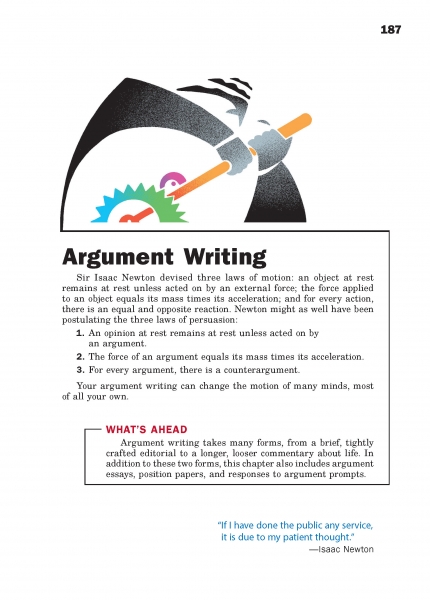Page 187 from

Start-Up Activity
Display the following proposition on the board: High-school students should carry school ID cards with built-in tracking devices.
Split your class into two equal teams and instruct one team to argue in favor of the proposition and the other team to argue against it. Provide time for both teams to brainstorm reasons and evidence to support their position and to nominate a captain to defend their position in front of the class. Set a time limit for each team's argument. Afterward, instruct the teams to choose a different person to counter the opposing team's statement. Set a brief time limit for counterarguments. Point out good arguments made by both teams, focusing on the use of logic and reasoning, not the volume of voices.
Let students know that the effectiveness of their argument writing will hinge on the same criteria, and they will need to make the same kinds of decisions when building their own arguments throughout the chapter. The guidelines to come will help them along the way.
Think About It
“A good leader can engage in a debate frankly and thoroughly, knowing that at the end he and the other side must be closer, and thus emerge stronger. You don't have that idea when you are arrogant, superficial, and uninformed.”
—Nelson Mandela

Start-Up Activity
Display the following proposition on the board: High-school students should carry school ID cards with built-in tracking devices.
Split your class into two equal teams and instruct one team to argue in favor of the proposition and the other team to argue against it. Provide time for both teams to brainstorm reasons and evidence to support their position and to nominate a captain to defend their position in front of the class. Set a time limit for each team's argument. Afterward, instruct the teams to choose a different person to counter the opposing team's statement. Set a brief time limit for counterarguments. Point out good arguments made by both teams, focusing on the use of logic and reasoning, not the volume of voices.
Let students know that the effectiveness of their argument writing will hinge on the same criteria, and they will need to make the same kinds of decisions when building their own arguments throughout the chapter. The guidelines to come will help them along the way.
Think About It
“A good leader can engage in a debate frankly and thoroughly, knowing that at the end he and the other side must be closer, and thus emerge stronger. You don't have that idea when you are arrogant, superficial, and uninformed.”
—Nelson Mandela











